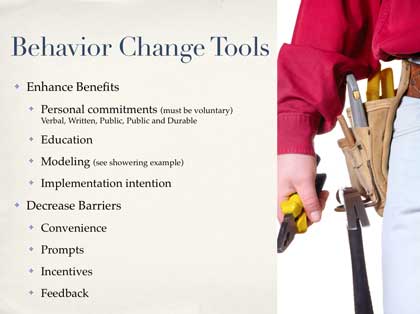It’s still pretty common to see public agencies rely almost entirely on advertising, information and education campaigns in an effort to encourage the public to adopt new sustainable practices. It would be nice if we could just pepper the public with flyers and sound bites, then watch the results come in.
A vast amount of evidence, however, shows that behavior shifts do not occur this way. It is no longer enough to simply educate about vital issues like water supply protection, toxic waste disposal and healthy habits.
To affect environmental change, you have to proactively bring forward campaigns that result in new, measurable changes in individual behavior. At Agency for Earth are pleased to be part of the movement that helps take environmental programs to the next level. Behavior change programs like Community-Based Social Marketing (CBSM) are key to this effort.
You can be a change agent if you prepare adequately and let the public help you. The five key steps in a Community-Based Social Marketing campaign lay the groundwork: 1) identify one or several behaviors that will bring about the environmental benefit you are seeking 2) do accurate research to find the barriers and benefits of these behaviors 3) devise a strategy to accentuate the benefits and mitigate the barriers 4) conduct pilot programs to test your campaign 5) if your pilot was successful implement broadly.
About the Community-Based Social Marketing (CBSM) process
In stage one if you choose a behavior with little impact you won’t get much benefit for the money you are spending. In stage two you must capture the true and real barriers and benefits to the behaviors you are trying to have people take on. Step three is critical because if you don’t have good strategies to address barriers and benefits your program will likely fail. Step four is necessary (at least highly recommended) because you want to test the assumptions underlying your strategies in the real world. Of course step five puts all your hard work into practice.
About step three—developing strategies: many people today know about asking people to make a commitment to take on environmentally beneficial behaviors. The temptation is to select a behavior and then go immediately to this powerful tool. Please remember that if you do not do a good job of identifying real-world barriers and benefits to this behavior you might be setting your program up for failure. Also, while commitments are powerful they are by no means the only behavior change tool at your disposal.
Go Beyond the “Low Hanging Fruit”
In many cases changing behavior in a widespread manner is possible. Programs like CBSM provide a scientific process to achieve these goals. When it comes to affecting public adoption of proactive conservation habits, for example in the case of California’s extended drought, where much of the low-hanging fruit has already been picked, science-based programs like CBSM become even more critical.
Agency for Earth networks with environmental protection managers seeking to launch more effective, successful campaigns and programs. We partner with leading research firms, to deliver sound marketing campaigns that produce not only new public habits, but new shared values and renewed commitment.

